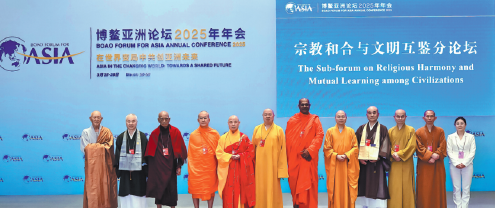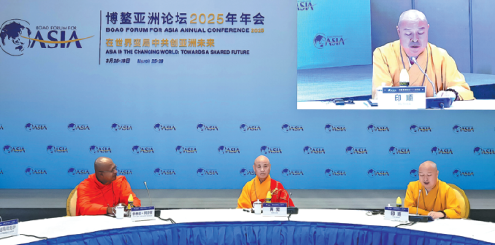Modern technology helping spread wisdom of ancient religious texts

Digitizing religious scriptures serves a purpose beyond preservation — it is a way to spread ancient wisdom across borders, languages and generations, top Buddhist monks and religious representatives from six countries said on Friday.
Speaking at the Subforum on Religious Harmony and Mutual Learning among Civilizations during the Boao Forum for Asia Annual Conference 2025 in South China's Hainan province, participants delved into the theme "All the Myriad Methods Converge in the Square-Inch Mind", discussing the significance and techniques of digitizing ancient Buddhist texts.
Now in its 10th year, the subforum is part of the South China Sea Buddhist Cultural Circle framework, a concept proposed in 2015 by Master Yinshun, deputy head of the Buddhist Association of China, to foster mutual understanding and peaceful coexistence through religious wisdom.
Faith in the digital age
In his opening remarks, Yinshun said the subforum's participants have been exploring innovations in digitizing Buddhist scriptures in recent years.
"We have compiled a digital encyclopedia of Chinese Buddhism, promoted the digital translation of Buddhist classics across the South China Sea region, and traced Buddhism's localization in China's Xinjiang Uygur autonomous region. Furthermore, we have submitted a proposal on the digitization of traditional Chinese classics to China's top political advisory body."
Master Yanjue, head of the Buddhist Association of China, noted: "Over two millennia, Buddhist texts have evolved from oral transmission to written forms, from monolingual manuscripts to multilingual printed editions. Since the 21st century, rapid advancements in information technology have ushered in a digital transformation.
"This digital shift not only enables the permanent preservation of precious palm-leaf manuscripts and paper-based scriptures but also facilitates devotional practices, Buddhist education and academic research. Recent breakthroughs in artificial intelligence further empower the translation of Buddhist texts, overcoming geographical and language barriers to the global propagation of Buddhist classics."
Master Hongxiang, a research assistant from the Centre of Buddhist Studies at the University of Hong Kong, highlighted the challenges in preserving the Dunhuang manuscripts, including fragmented scrolls, aging paper and fading ink, calling the collation of The Liturgical Manual for Five-Session Pure Land Recitation, a treasure among the manuscripts, a race against time.
"Digital technology has brought transformative changes," he said. "Through high-resolution scanning and multispectral imaging, we can decipher blurred characters beneath ink traces from a millennium ago. AI-assisted collation enables rapid comparison of textual variants across different manuscripts, restoring the original text."
He emphasized that digitization is not just a preservation method but a key to revitalizing ancient texts. "Transforming the chanting rhythms in The Liturgical Manual for Five-Session Pure Land Recitation into visualized audio allows modern audiences to intuitively experience the cadence of Tang Dynasty (618-907) Sanskrit hymns."
Kirinde Assaji, chief incumbent of Hunupitiya Gangaramaya Temple in Colombo, Sri Lanka, pointed out that digitization is not just a technical process — it is a way to make ancient wisdom accessible globally and for future generations.
"AI can help translate ancient texts into different languages. Cloud-based digital libraries will provide easy access for scholars and practitioners. Blockchain technology can protect the authenticity of these sacred texts, while virtual and augmented reality can offer new and engaging ways to experience Buddhist teachings," he said.
Addressing challenges
Master Guangquan, deputy secretary-general of the Buddhist Association of China and abbot of Lingyin Temple in Hangzhou, East China's Zhejiang province, said the temple has developed an AI-powered optical character recognition engine for ancient texts, a digital tool repository and other platforms to provide robust technical support for the digitization workflow.
Reflecting on the challenges, Guangquan said that hiring interdisciplinary professionals and employing innovative approaches have been crucial.
To manage voluminous scriptures and multiple versions, they created a clustered collation method to ensure quality and efficiency. For rare characters missing from digital databases, they developed lightweight font solutions. Guidelines for orthographic standardization were also formulated to guide proofreaders in handling variant glyphs.
Through these efforts, the temple has systematically digitized major canons such as Jingshan Canon and Sixi Canon, achieving in-depth collation and intelligent utilization of Buddhist texts.
Despite progress, challenges remain, particularly in obtaining high-quality scans and copyright permissions, Guangquan noted. "With Buddhist resources scattered across monasteries, libraries and institutions globally, consolidating these assets requires collective commitment."
Envisioning the future
Echoing Guangquan, Master Jong-Rim, honorary chairman of the Research Institute of Tripitaka Koreana, Jogye Order of Korean Buddhism, called for interdisciplinary and international cooperation to advance digitization.
He highlighted two "visionary projects" that demand global participation: a comprehensive Tripitaka system that integrates multilingual Buddhist texts into a unified digital ecosystem and a conceptual lexicon development project that traces doctrinal evolution across languages and cultures.
"These undertakings require synergy between computer scientists and Buddhist scholars and, most critically, the collective commitment of global Buddhist communities," he noted.
Hongxiang from Hong Kong said: "The preservation of the Dunhuang manuscripts requires interdisciplinary collaboration; the construction of digital Buddhist canons depends on the sharing of global resources; and the continuity of human civilization relies on each generation's sense of mission."
Guangquan outlined plans to enhance the quantity and quality of Buddhist scripture digitization at Lingyin Temple.
He revealed that Lingyin Temple will establish a comprehensive digital repository of Buddhist scriptures, focusing on endangered woodblock canons, Dunhuang fragments, texts lost to foreign countries, stone inscriptions and folk manuscripts. Technologies such as 3D scanning and multispectral imaging will be utilized to preserve both physical and informational integrity.
To improve quality, the temple will develop cross-disciplinary knowledge graphs and upgrade databases with AI-powered Q&A tools capable of semantic retrieval and doctrinal analysis, according to Guangquan.
huyuyan@chinadaily.com.cn




















